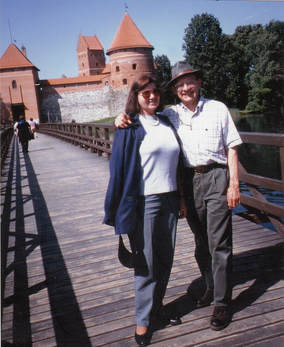 Sherrill & Bruce, Trakai Castle, Lithuania
Sherrill & Bruce, Trakai Castle, Lithuania Maaria, our Estonian guide, was small, with big brown eyes, didn't look older than twenty, though she probably was, and spoke good enough English to launch into a tirade against the Soviets and their brutal impact on Estonia as she drove us past deserted Stalin-era factories and ugly apartment blocks until we reached Tallinn's Old Town, somehow spared from both bombs and Russian mutilation.
Sherrill and I exchanged looks, but didn't respond much.
So young and so angry, Sherrill and I agreed later.
Estonia was the first of the former Soviet satellite countries along the Baltic that we were visiting. It was exciting to be there, while they were feeling their way into the challenging world of personal choice and free markets. For the young people, the symbol of this brave new world seemed to be the mobile phone, which we saw flourished everywhere like a sword slaying the dragon the of dictatorship. Maaria had told us that Estonia hoped to join the European Economic Union very soon.
From our hotel window we could see the towers and red roofs of the Old Town and passing trams brightly painted with ads.
"This is my idea of breakfast," Sherrill said at the buffet the next morning, as we filled our plates with herring, trout, cheese, and dark breads.
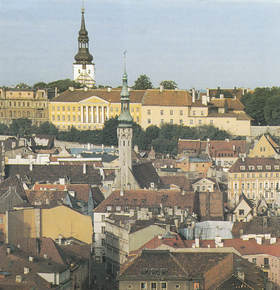 Old Town Tallinn, Estonia
Old Town Tallinn, Estonia "They're going to be torn down," Maaria told us. "To make room for development."
We couldn't tell if she approved or disapproved. She took us to a yachting harbor built by the Soviets when they were hosting the Olympic Games.
"It looks nice, but it's falling apart, like everything else they built."
Nearby, at a hillside Folk Music Stadium, costumed performers were getting ready for a singing competition between Estonia and Finland. That evening, some of the Estonian team crowded into our hotel, men wearing oak leaf garlands, women carrying bouquets of roses, celebrating their victory. Folk songs, Maaria told us, helped preserve Estonian culture when they were occupied by other countries. The next morning, when I went for a walk I saw large posters advertising Tina Turner's coming appearance. Was this the beginning of a new cultural invasion?
"I have to make a decision," she told us. "Whether to be a teacher or do something else with my English skills."
We told her a little of what we knew, but didn't want to urge her in any specific direction.
The outdoor museum was a collection of thatch-roofed farmhouses and barns moved from across Estonia. Although the museum was to show a traditional way of life, one old farmhouse also commemorated the deportations of thousands of Estonians to the Russian Gulag after World War Two. It was left as it was the night Russians came to take away the occupants, with photographs of the family and other Estonian victims.
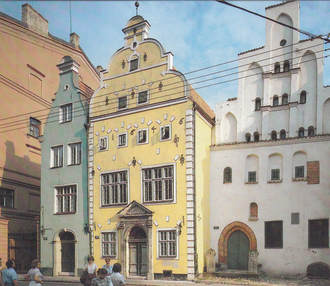 Old Town Riga, Latvia
Old Town Riga, Latvia "On this road," Rita told us, "in 1989, a human chain of a million people from the three Baltic countries stretched from Tallin in the north down to Vilnius in Lithuania, swearing that we'd all be independent again."
Sherrill commented about how beautiful the countryside was.
"The Russians didn't bother to destroy it—except where they built factories to make things to go back to Russia."
Sherrill nudged me.
"Look," she said, pointing out the window to a high-shouldered, long-legged stork hiking through a field.
The midsummer festival was coming soon, Rita told us, on June 23, the eve of St. John's Day, or the "Festival of Johns" for all men named John, rather than on the summer solstice.
"On midsummer night," she explained, "everyone is supposed to stay awake all night and bathe naked in a river or lake or in the dew of a meadow to ensure good harvests." She laughed: "Of course, there's much celebration and eating and drinking! We have a long history of worshipping nature, giving god-like powers to trees and rocks and lakes." She smiled. "The Baltic states were the last in Europe to be Christianized."
The pre-Christian gods and goddesses weren't shown as figures or statues, but in symbols or shapes that could be drawn or woven in fabric. Rita had brought her fifteen year-old daughter—named Mara, after the earth goddess—along for the bus ride.
"Why," Mara asked us, "are so many school children killed in America?"
"Because of guns," Sherrill answered.
This conversation happened almost twenty years ago, not last week.
"The SS was a voluntary corps and I know that thousands of Latvians were SS guards in the concentration camps."
During the trip, Sherrill and I became friends with the woman, Vera, and her husband, and learned that she'd spent time in Auschwitz and two other Nazi camps.
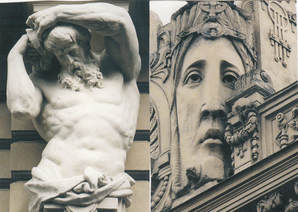 Art Nouveau decorations, Riga, Latvia
Art Nouveau decorations, Riga, Latvia Passing the now familiar Soviet-era apartment blocks and deserted factories, we drove into Riga's city center, block after block in the Art Nouveau style, with fanciful leafy decorations, sculptures of gargoyles and human faces and figures.
Our hotel was near the "Monument to Liberty" that dates from the 1930s, with a tall figure of a woman holding three stars above her head.
"During the resistance to Soviet rule," Rita told us, "she had great symbolic importance. People still leave flowers at her base."
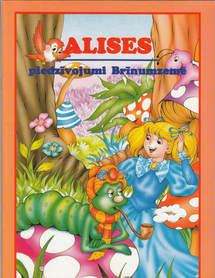
The next afternoon, Sherrill and I found a bookstore where she bought a copy of Alice's Adventures in Wonderland in Latvian for her collection. A young man near Town Hall Square was selling matrioshka nesting dolls, with first Bill Clinton, then Monica Lewinsky, followed by a smaller, angry Hilary.
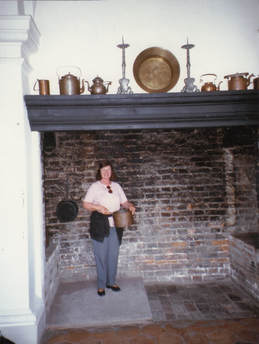 Sherrill, Rundale Palace, Latvia
Sherrill, Rundale Palace, Latvia A new guide, Darja, took us from Latvia to Vilnius, the capital of Lithuania. Although, as one of the company managers, she didn't usually conduct tours and was filling in for someone, she told us with some annoyance, "I still have to do all of the usual female jobs at home." She looked at Sherrill. "I have to give my husband fancy meals—you know, take care of 'his majesty.' That's the way it is here. At Christmas, I have to fix a dozen or more kinds of sweets—it's the tradition. If I don't, I'm a bad housewife."
"Now, we have the freedom we wanted, but we still have corruption in government, economic inequality, food shortages. Old people lost their savings when the banks failed....."
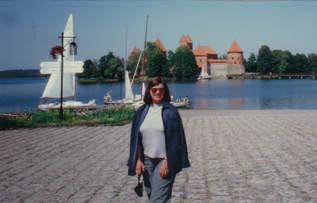 Sherrill, Trakai Castle, Lithuania
Sherrill, Trakai Castle, Lithuania Darja showed us where the city's two Jewish ghettos were and told us about the extermination of thousands of Lithuanian Jews. A small monument to the victims stood on the site of the largest synagogue in Vilnius. The Germans damaged the synagogue, but after the war the Russians blasted it to nothing. Later, we drove past the forest outside of Vilnius and the mass graves of 100,000 people shot by the Nazis: 70,000 Jews, 30,000 gypsies, plus Polish intelligentsia, Lithuanians, war prisoners, and resisters.
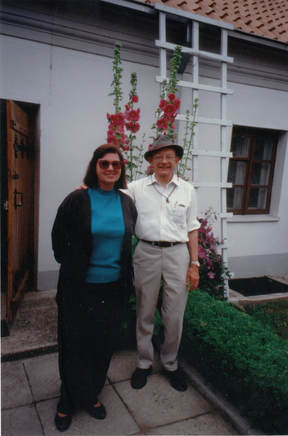 Sherrill & Bruce, Lithuania
Sherrill & Bruce, Lithuania 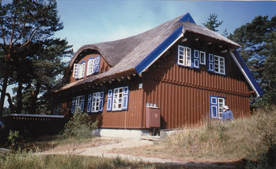 Thomas Mann's house, Nida Spit, Lithuania
Thomas Mann's house, Nida Spit, Lithuania 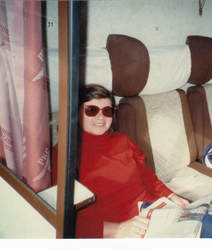 Sherrill on way to Poland
Sherrill on way to Poland 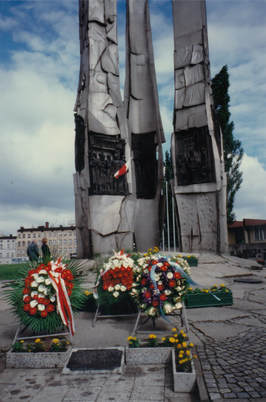 Gadansk Monument to Rebellion
Gadansk Monument to Rebellion If you find these posts interesting, why not explore the rest of my website, too? Just click on the buttons at the top of the page and discover where they take you—including to several complete short stories and excerpts from my novels.
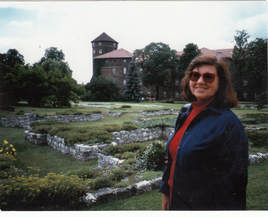
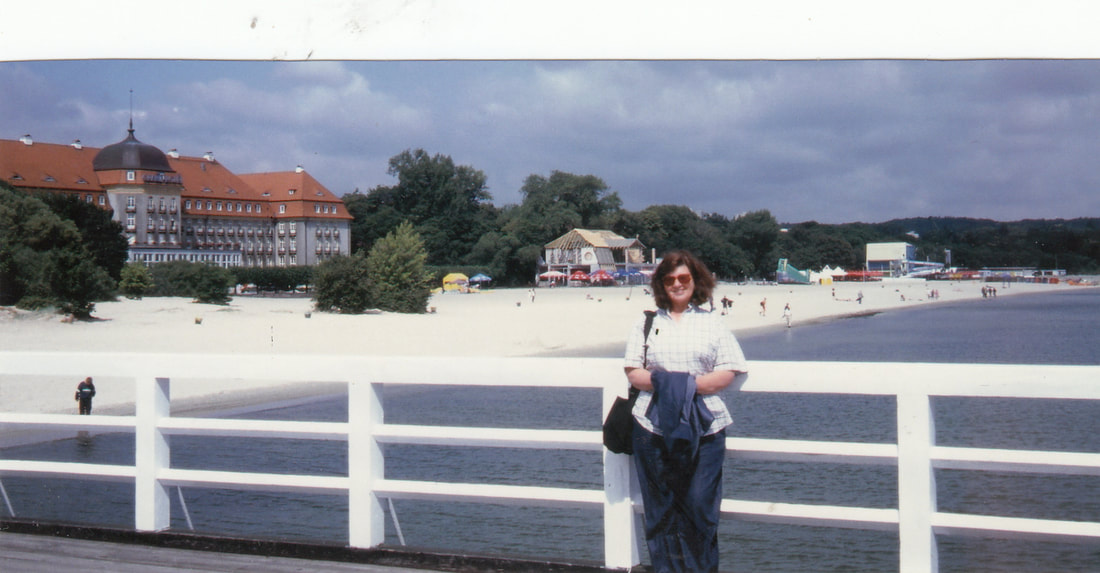
 RSS Feed
RSS Feed